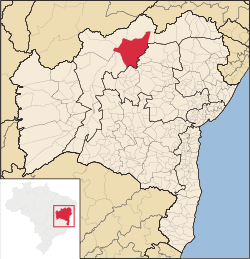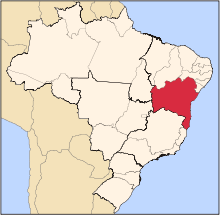Sento Sé
Sento Sé is a municipality in the state of Bahia in the North-East region of Brazil. It covers 12,698.76 km2 (4,903.02 sq mi), and has a population of 41,102 with a population density of 1.28 inhabitants per square kilometer. Sento Sé is located 689 kilometres (428 mi) from the state capital of Salvador.[1][2]
Sento Sé Município de Sento Sé | |
|---|---|
 Flag  Seal | |
 Location of Sento Sé in Bahia | |
 Sento Sé Location of Sento Sé in Brazil | |
| Coordinates: 09°44′45″S 41°53′06″W | |
| Country | |
| Region | Northeast |
| State | |
| Founded | 1832 |
| Government | |
| • Mayor | Ana Luiza Rodrigues da Silva Passos (2007-2020) (PSD) |
| Area | |
| • Total | 12,698.76 km2 (4,903.02 sq mi) |
| Population (2014) | |
| • Total | 41,102 |
| • Density | 3.2/km2 (8.4/sq mi) |
| Demonym(s) | Sentoseense |
| Time zone | UTC-3 (BRT) |
| Website | www |
Sento Sé has a peculiar history. It is among the five cities that had to be flooded because of construction of the Sobradinho Dam. The new Sento Sé erected in 1974, was being gradually populated by residents of the former headquarters, which plunged into the waters.
History
The name Sento Sé comes from an ancestral indigenous tribe called Centoce. The first foreign settlers were Portuguese sugar cane producers that built mills in that area. The foundation of the municipality was in 1832 by a provincial decree.
In the 1970s the city passed for one of the most complicated moments. The construction of Sobradinho Dam obligated the moving of the city and another little communities close to the river to another place 62 kilometers away, in 1974.
References
- "Dados Básicos" (in Portuguese). Sento Sé, Bahia, Brazil: Prefeitura Municipal de Sento Sé. 2015. Retrieved 2015-08-22.
- "Sento Sé" (in Portuguese). Brasília, Brazil: Instituto Brasileiro de Geografia e Estatística. 2015. Retrieved 2015-06-14.
